There are ten colors and nine shapes of traffic signs. Each shape and each color has an exact meaning, so you must acquaint yourself with all of them.
| GREEN: | Guide, directional information. | ||
| RED: | Stop, do not enter or wrong way. | ||
| BLUE: | Motorist services guidance. Also used to identify parking spaces for disabled drivers. | ||
| ORANGE: | Construction and maintenance warning. | ||
| BROWN: | Public recreation areas, guidance to areas of cultural and historical significance. | ||
| YELLOW: | General warning and advisory of unexpected roadway conditions. | ||
| WHITE: | Regulatory. | ||
| BLACK: | Regulatory. | ||
| FLUORESCENT YELLOW GREEN: | High emphasis warning of school, pedestrian, and bicycling activity. | ||
| FLUORESCENT PINK: | Warning of incident Management activity. | ||
The shape of a road sign can tell you as much about the sign's message as its color.
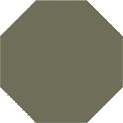 |
Octagon: Exclusively for stop signs. |
 |
Horizontal Rectangle: Generally for guide signs. |
 |
Triangle: Exclusively for yield signs. |
 |
Pennant: Advance warning of no passing zones. |
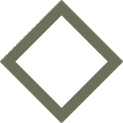 |
Diamond: Exclusively to warn of existing or possible hazards on roadways or adjacent areas. |
 |
Vertical Rectangle: Generally for regulatory signs. |
 |
Pentagon: School advance and school crossing signs. |
 |
Round: Railroad advance warning signs. |
 |
Crossbuck: Railroad crossing. |
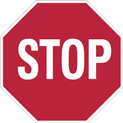 |
Stop Signs are always octagonal (8 sided). A stop sign means that you must bring your vehicle to a complete halt at the marked stop line. If there is no marked stop line, stop before entering the crosswalk on the near side of the intersection. If there is no crosswalk, stop at a point nearest the intersecting roadway where you have a clear view of approaching traffic on the intersecting roadway before entering the intersection. |
 |
A 4-Way Stop sign means that there are four stop signs at this intersection. Traffic from all four directions must stop. The first vehicle to reach the intersection should move forward first. If two vehicles reach the intersection at the same time, the driver on the left yields to the driver on the right. |
 |
Triangle: Yield Slow down and give vehicles crossing your path the right-of-way. If the way is clear, you may move forward slowly without stopping. Yield signs are usually placed where auxiliary roads lead into major roads. |
 |
Pennant: No Passing You are entering a no passing zone. This sign is placed on the left side of the road, facing the driver. |
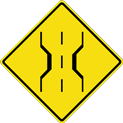 |
Diamond: Warning Narrow bridge. These signs warn you of special conditions or dangers ahead. Words or symbols on the sign will show why you need to use caution. See pages 31-34 for typical warning signs. |
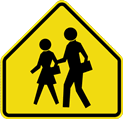 |
Pentagon: School Sign This five-sided sign means you are near a school. Watch for children. |
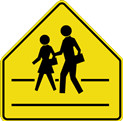 |
School Crossing As you approach this sign, slow down, watch for children crossing the road. Stop if necessary. Obey signals from any crossing guards. |
 |
Children Crossing Slow to posted speed. Watch for children! |
Here are some common warning signs. These signs give you advance notice of possible hazards ahead. Drive with caution.
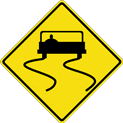 |
Slippery When Wet In wet weather, drive slowly. Do not speed up or brake quickly. Make sharp turns at a very slow speed. |
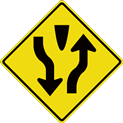 |
Divided Highway Ahead The highway ahead is divided into two one-way roadways. Keep to the right. |
 |
Divided Highway Ends The divided highway on which you are traveling ends 350 to 500 feet ahead. You will then be on a roadway with two-way traffic. Keep to the right. |
 |
Low Clearance Do not enter if your vehicle is taller than the height listed on the sign. |
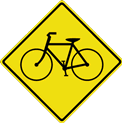 |
Bicycle Crossing This sign warns you in advance that a bikeway crosses the roadway ahead. |
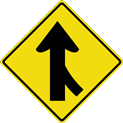 |
Merging Traffic You are coming to a point where another traffic lane joins the one you are on. Watch for other traffic and be ready to yield the right-of-way when necessary. |
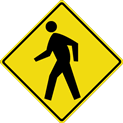 |
Pedestrian Crossing Watch for people crossing the street. Slow down or stop if necessary. |
 |
Narrow Bridge The bridge is wide enough to accommodate two lanes of traffic, but with very little clearance. |
 |
Dip There is a low place in the road. Go slowly and be ready to stop if the dip is filled with water. |
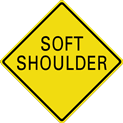 |
Soft Shoulder The dirt on the side of the road is soft. Don't leave the pavement except in an emergency. |
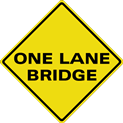 |
One Lane Bridge The bridge is wide enough for only one vehicle at a time. Make sure the bridge is clear of oncoming traffic before you cross. |
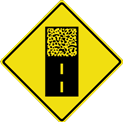 |
Pavement Ends The road surface ahead changes from a hard surfaced pavement to a low-type surface or earth road. |
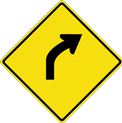 |
Right Curve Slow your speed and keep well to the left. The road will curve to the right. |
 |
Double Curve The road will curve to the right, then to the left. Slow your speed, keep to the right, and do not pass. |
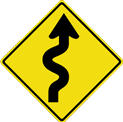 |
Winding Road There are several curves ahead. Drive slowly and carefully. |
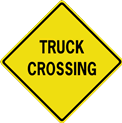 |
Truck Crossing Watch for trucks entering or crossing the highway. |
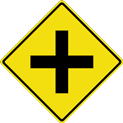 |
Cross Road A road crosses the main highway ahead. Look to the left and right for other traffic. |
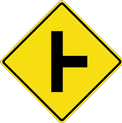 |
Side Road Another road enters the highway from the direction shown. Watch for traffic from that direction. |
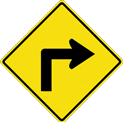 |
Sharp Right Turn The road will make a sharp turn to the right. Slow your speed, keep to the right, and do not pass other vehicles. |
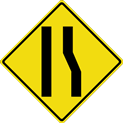 |
Reduction of Lanes There will be fewer lanes ahead. Traffic must merge left. Drivers in the left lane should allow others to merge smoothly. Right lane ends. |
 |
Advisory Speed Sign The highest safe speed you should travel around the curve ahead is 25 miles per hour. Advisory speed signs may be used with any diamond-shaped warning sign. |
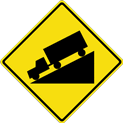 |
Hill / Downgrade Slow down and be ready to shift to lower gear to control speed and save brakes. |
 |
Yield Ahead This sign warns of a yield sign ahead. Slow down and be prepared to stop at yield sign or adjust speed to traffic. |
 |
Traffic Signal Ahead This sign warns of traffic signals at the intersection ahead. Slow down; poor visibility is likely. |
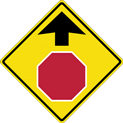 |
Stop Sign Ahead When you come to this sign, slow down to be ready to stop at the stop sign check. |
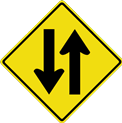 |
Two-Way Traffic Ahead The one-way street or roadway ahead ends. You will then be facing oncoming traffic. |
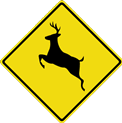 |
Animal Crossing The animal pictured on the sign is common in this area: watch for this species crossing the road particularly during twilight and night-time hours. |
These signs tell you the law, so you must follow their instructions.
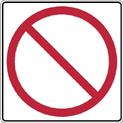 |
Remember that a red circle with a slash means NO. The sign shows you what is not allowed. |
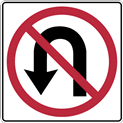 |
NO U-TURN - You cannot make a complete turn to go in the opposite direction where this sign is displayed. No U-turn. |
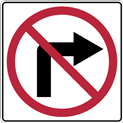 |
You must not make a right turn at this intersection. |
 |
50 miles per hour is the highest speed you can safely travel in this area. |
 |
Speeding Fines Doubled. This is a Florida Standard sign that applies to both active school and work zones. |
 |
You cannot go straight ahead. You must turn either to the right or left. |
 |
You are going the wrong way on an expressway exit ramp. Do not drive past this sign. Turn around immediately. |
 |
A divided highway is ahead. Stay on the right side of the divider. |
 |
Parking in this space is only for vehicles displaying an official permit and transporting a disabled person. |
 |
You may travel only in the direction of the arrow. |
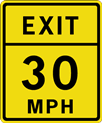 |
This sign lists the maximum recommended safe speed for an entrance or exit on an expressway. Slow down to whatever speed is shown. |
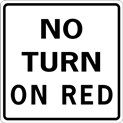 |
You may not turn right or left during the red light. You must wait for the signal to turn green. |
 |
A diamond-shaped marking shows that a lane is reserved for certain purposes or certain vehicles. The lanes are usually reserved for buses or car-pool vehicles during rush hour traffic. |
 |
The center lane is shared for left turns in both directions of travel. |
 |
You must not pass any other vehicles going in the same direction as you are while you are in this area. |
 |
When you have passed this sign, you are again permitted to pass other vehicles with care. |
 |
Traffic in left lane must turn left at the intersection ahead. |
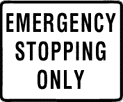 |
Stopping permitted only for emergencies. |
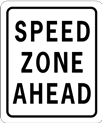 |
You are approaching an area where a speed zone has been established. |
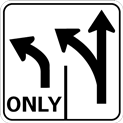 |
At the intersection ahead traffic in left lane must turn left and traffic in adjoining lane may turn left or continue straight ahead. |
 |
This sign is used on multiple lane highways to advise slower driving traffic to stay in the right hand lane, and also to do so when approached from behind by other traffic even if you are doing the speed limit. |
 |
This marks a one-way roadway with traffic coming toward you. You must not enter the one-way roadway at this point. |
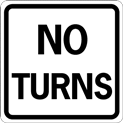 |
You must not turn either to the right or to the left at this intersection. |
 |
If you park, you must always park off the pavement of the highway. |
 |
When entering a right turn lane motorists will conflict with bicyclists traveling straight. Always yield. |
There are several signs, signals and pavement markings that indicate highway-railroad crossings. When you see one of them, slow down and be ready to stop.
Trains cannot stop quickly. An average freight train traveling at 30 MPH needs a stopping distance of more than half a mile. Longer trains moving at faster speeds can take one and a half miles or more to stop. Any pedestrian or person driving a vehicle and approaching a railroad-highway grade crossing must stop 50 feet, but not less than 15 feet from the nearest rail of the railroad when: the electrical or mechanical warning devices are flashing, the crossing gate is lowered, a human flagger is warning of an approaching train, or an approaching train is clearly visible and is in close proximity to the railroad-highway grade crossing. Do not proceed until you can do so safely.
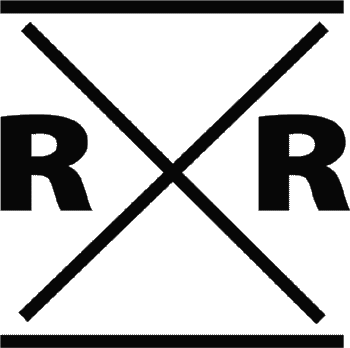 |
PAVEMENT MARKING Pavement markings, consisting of an RXR followed by a stop line closer to the tracks, may be painted on the paved approach to a crossing. |
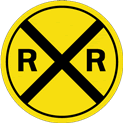 |
ADVANCE WARNING SIGN The advance warning sign is usually the first sign you see when approaching a highway-rail intersection. The advance warning sign advises you to slow down, look and listen for a train, and be prepared to stop if a train is approaching. |
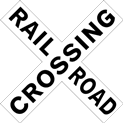 |
CROSSBUCK SIGN Crossbuck signs are found at highway-rail intersections. They are yield signs. You are legally required to yield the right of way to trains. Slow down, look and listen for a train, and stop if a train approaches. Railroad crossbuck signs are found at most crossings. If there is more than one track, the sign below the crossbuck will show the number of tracks at the crossing. |
 |
FLASHING RED LIGHT SIGNALS At many highway-rail crossings, the crossbuck sign has flashing red lights and bells. When the lights begin to flash, stop! A train is approaching. DO NOT STOP ON THE TRACKS OR WITHIN 15 FEET OF THE CROSSING. If there is more than one track, make sure all tracks are clear before crossing. Do not move forward until you can do so safely. In heavy traffic make sure there is room for your vehicle on the other side before starting to cross. |
 |
GATES Many crossings have gates with flashing red lights and bells. Stop when the lights begin to flash and before the gate lowers across your road lane. If the gates are down, the road is closed. It is against the law to drive around or under a crossing gate, either down or being opened or closed. Do not move forward until the gates are raised and the lights stop flashing as there may be a train approaching on an adjacent track. |
Always approach highway-railroad crossings at a reasonable speed and be prepared to stop if you have to. Be especially alert when you are following buses or trucks, which may have to stop at highway-railroad crossings even when gates are up and the warning lights are not flashing. If your car stalls on the tracks don't hesitate. Get yourself and your passengers out and away from the car immediately. If a collision is imminent, the safest direction is toward the train but stay off the tracks. That way you will be least likely to be hit by your vehicle or any debris from the collision.
Drawbridges are mechanical bridges over navigable waters that raise or turn to allow marine traffic to go under them. When they begin to move the roadway is closed to all traffic. Always use caution when driving or walking over a drawbridge.
These should be treated just like a regular traffic control signal.


This is the first sign you see when approaching a drawbridge. This sign advises you to slow down and look for the DRAWBRIDGE SIGNAL. If the yellow light is flashing to indicate the drawbridge is in operation and the DRAWBRIDGE SIGNAL is red, prepare to stop.
Many drawbridges have gates with flashing red lights and bells. Stop when the lights begin to flash and before the gate lowers across your road lane. If the gates are down, the road is closed. It is against the law to drive around or under a crossing gate, either down or being opened or closed. Do not move forward until the gates are raised and the lights stop flashing.
Various traffic control devices are used in road construction and maintenance work areas to direct drivers and pedestrians safely through the work site and to provide for the safety of highway workers.
Be prepared to reduce your speed and use caution when directed to do so by a sign, flagger and/or police officer.
Construction and maintenance signs are used to notify drivers of unusual or potentially dangerous conditions in or near work areas. Most signs used in highway and street work areas are diamond shaped.
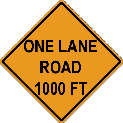

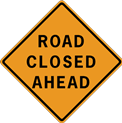
Barricades, vertical panels, drums, and cones are the most commonly used devices to alert drivers of unusual or potentially dangerous conditions in highway and street work zones. These devices are used to guide the drivers safely through the work area, and at night, they may be equipped with warning lights. When a Road Closed sign is displayed, do not drive on this road. Look for a detour or another route.
Stripes on barricades and panel devices slope downward in the direction traffic must travel.


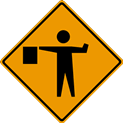
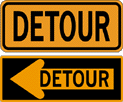






Flashing arrow panels are used both during the day and at night to give advance warning and directional information to drivers, where it is necessary to move to the right or to the left into another lane.
A horizontal flashing bar indicates a warning - use caution approaching the work area.
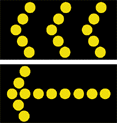
Flaggers are often provided in highway and street work zones to stop, slow, or guide traffic safely through the area.
Flaggers wear orange vests or jackets and use red flags or stop/slow panels to direct traffic through work zones.
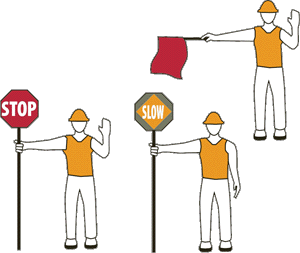
Slow Moving Vehicle
Vehicles going less than 25 miles per hour (such as farm equipment) must display this sign on the rear when using public highways.
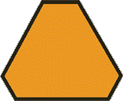
Green and white signs give information about directions and distances. Guide signs on expressways show you which lanes to use to get where you want to go. Routes that run generally East-West have even numbers and those running North-South have odd numbers.

Blue and white signs direct you to services, such as gas, food, motels and hospitals.
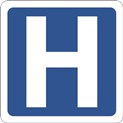
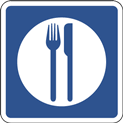
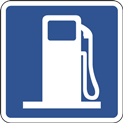

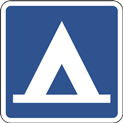
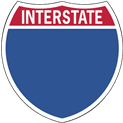
Brown and white signs point out scenic areas and parks.
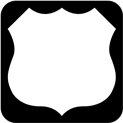
Take your Florida Drug and Alcohol Course online with DriverLicenseSchool.com! Sign up by clicking the "GO" button below.
Take your Florida Learners License Test online with DriverLicenseSchool.com! Sign up by clicking the "GO" button below.